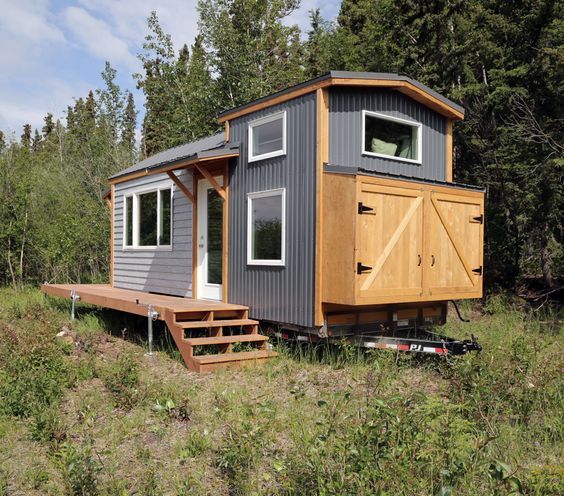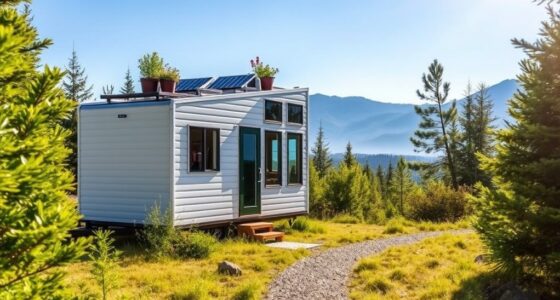To design mobile tiny homes for extreme climates, prioritize advanced insulation like spray foam or reflective barriers to maintain comfortable temperatures. Incorporate strategic ventilation systems such as HRVs or ERVs to control moisture and air quality without losing heat or coolness. Additionally, optimize window placement with double-glazed or low-emissivity glass and include shading to reduce heat gain. Considering these techniques can make your tiny home more energy-efficient and livable—discover more tips to master extreme climate conditions.
Key Takeaways
- Use climate-specific insulation materials like spray foam for cold or reflective barriers for hot environments.
- Incorporate controlled ventilation systems such as HRVs or ERVs to manage moisture and temperature efficiently.
- Design window placement for optimal natural light and cross-ventilation, with proper shading and high-performance glazing.
- Select lightweight, durable materials suitable for mobile structures that withstand extreme temperature fluctuations.
- Implement sealing around doors, windows, and joints to prevent drafts and maintain consistent interior temperatures.

Designing mobile tiny homes offers a unique challenge: maximizing space while maintaining comfort and style. When you’re building for extreme climates, this balancing act becomes even more crucial. You need to incorporate effective insulation techniques to keep the interior comfortable regardless of outside temperatures. High-quality insulation isn’t just about adding foam or fiberglass; it’s about choosing the right materials for the environment. For cold climates, consider spray foam or rigid foam panels that provide superior thermal resistance and help prevent heat loss. In hot environments, reflective barriers and radiant barriers can deflect heat away, keeping the interior cooler. Combining these with proper sealing around windows, doors, and joints minimizes drafts and air leaks, which is essential for maintaining consistent temperatures.
Ventilation strategies are equally essential in extreme climates. Proper airflow prevents moisture buildup, reduces condensation, and helps regulate temperature fluctuations inside your tiny home. In colder regions, you want to balance insulation with controlled ventilation. Installing heat recovery ventilators (HRVs) or energy recovery ventilators (ERVs) can bring in fresh air without sacrificing warmth. These systems exchange indoor air for outdoor air while reclaiming heat, making them energy-efficient and effective. For hot climates, ventilation needs to promote airflow that pulls hot air out and draws cooler air in. Installing roof vents, exhaust fans, or even small windows that can be opened during cooler parts of the day helps facilitate this airflow naturally.
You also need to think about placement and size of windows carefully. Larger windows may bring in natural light and connect you to the outdoors, but they can also be a source of heat gain or loss if not correctly shaded or insulated. Using double-glazed or low-emissivity glass can improve energy efficiency. Additionally, designing for cross-ventilation by positioning windows on opposite sides of your tiny home allows breezes to flow through, which is especially helpful during milder days or evenings.
Frequently Asked Questions
How Do Tiny Homes Handle Extreme Temperature Fluctuations?
You can handle extreme temperature fluctuations in tiny homes by integrating solar panels for efficient energy use and maintaining proper insulation. Solar integration helps power heating and cooling systems, reducing reliance on external sources. Additionally, water conservation techniques, like low-flow fixtures, keep resource use minimal during temperature extremes. These strategies guarantee your tiny home remains comfortable and sustainable, even when weather conditions change drastically.
What Insulation Materials Are Best for Harsh Climates?
You’ll want insulation materials that laugh in the face of harsh weather, like spray foam or rigid foam boards, because they’re excellent at sealing out thermal bridges and moisture. These materials provide a continuous barrier, preventing pesky drafts and moisture infiltration. Don’t forget to add moisture barriers to protect your tiny haven from the elements. With these, your tiny home stays cozy, no matter how extreme the climate dares to get.
Are Off-Grid Power Solutions Viable in Extreme Weather?
Yes, off-grid power solutions like solar panels and wind turbines are viable in extreme weather. You can harness solar energy even in cold or cloudy conditions, while wind turbines work well in windy environments. By combining both, you guarantee a steady power supply regardless of weather fluctuations. Proper placement and durable equipment are essential, so you’ll want to choose high-quality, weather-resistant systems to keep your tiny home powered year-round.
How Do Tiny Homes Prevent Frost or Heat Damage?
You prevent frost or heat damage by using solar shading to block excess sun in summer and retain warmth in winter. Incorporate thermal mass materials like concrete or stone inside your tiny home to absorb, store, and gradually release heat, helping maintain stable temperatures. Insulate thoroughly and seal all gaps, ensuring your tiny home stays comfortable regardless of extreme weather, while solar shading and thermal mass work together to protect against temperature swings.
What Are the Best Ventilation Strategies for Extreme Climates?
Think of your tiny home as a gust of fresh air in a desert or snowstorm. You should use passive cooling techniques, like cross-ventilation and strategically placed vents, to keep the temperature comfortable. Pair this with humidity control measures, such as dehumidifiers or vapor barriers, to prevent mold and dampness. These strategies work together to create a stable, livable environment in extreme climates, ensuring your home adapts smoothly to the weather outside.
Conclusion
So, you’ve mastered the art of tiny home design for the harshest climates—because nothing says “luxury” like braving the elements in a mobile box. With clever insulation and innovative features, you’ll prove that size truly doesn’t matter, especially when Mother Nature’s throwing her worst at you. Soon, you’ll be the envy of all who dream of tiny living… as long as they don’t mind the cold, heat, or the relentless charm of extreme living. Cheers to tiny resilience!








